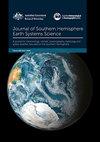自1851年以来澳大利亚东海岸气旋的大规模驱动者
IF 3.6
4区 地球科学
Q1 Earth and Planetary Sciences
引用次数: 0
摘要
副热带海洋低压系统是影响澳大利亚东海岸的最复杂和最具破坏性的风暴类型之一。这类风暴通常被称为东海岸气旋(ECC),在深秋和初冬期间最活跃,此时塔斯曼海地区的斜压性增加。事实证明,ECC在事件和季节时间尺度上的预测都具有挑战性。通过使用气旋检测算法进行再分析,客观地确定了风暴活动数据集,提高了对卫星数据覆盖时代ECC驱动因素的理解。在本研究中,我们尝试使用20世纪再分析版本2c (20CRv2c)将这些数据集扩展到1851年。然而,由于观测数据的缺乏,20CRv2c的不确定性随着时间的推移而增加,而且在19世纪,单个气旋的数量往往被低估。本文探讨了另一种方法,即根据季节性大气-海洋环流模式估计风暴活动。1955 ~ 2014年期间的季节ECC频率与区域海平面压力和海温(SST)模式显著相关。这些模式用于在个体事件没有得到很好模拟的早期减小20CRv2c。自1851年以来,风暴最猛烈的时期似乎是1870年至19世纪90年代初,以及1950年至70年代初。自1976年以来,大多数冬季的总风暴活动低于长期平均水平。在典型的负年代际太平洋涛动(IPO-ve)期间,西南太平洋海温相对温暖,有利于频繁发生ECC事件。副热带气旋形成与负南环模(SAM-ve)和南塔斯曼海阻塞有关。副热带气旋形成与塔斯曼海中部的SAM+ve和阻塞有关。虽然降尺度方法在从大尺度环流估计季节性风暴活动方面显示出一定的技巧,但它无法克服19世纪基于数据缺乏的不确定性,当时20CRv2c在南半球大部分地区实际上是不受约束的。19世纪的风暴频率估计很难核实,应参照现有的文献证据谨慎地加以解释。本文章由计算机程序翻译,如有差异,请以英文原文为准。
Large-scale drivers of Australian east coast cyclones since 1851
Subtropical maritime low-pressure systems are one of the most complex and destructive storm types to impact Australia’s eastern seaboard. This family of storms, commonly referred to as East Coast Cyclones (ECC), is most active during the late autumn and early winter period when baroclinicity increases in the Tasman Sea region. ECC have proven challenging to forecast at both event and seasonal timescales. Storm activity datasets, objectively determined from reanalyses using cyclone detection algorithms, have improved understanding of the drivers of ECC over the era of satellite data coverage. In this study we attempt to extend these datasets back to 1851 using the Twentieth Century Reanalysis version 2c (20CRv2c). However, uncertainty in the 20CRv2c increases back through time due to observational data scarcity, and individual cyclones counts tend to be underestimated during the 19th century. An alternative approach is explored whereby storm activity is estimated from seasonal atmosphere-ocean circulation patterns. Seasonal ECC frequency over the 1955 to 2014 period is significantly correlated to regional sea-level pressure and sea surface temperature (SST) patterns. These patterns are used to downscale the 20CRv2c during early years when individual events are not well simulated. The stormiest periods since 1851 appear to have been 1870 to the early 1890s, and 1950 to the early 1970s. Total storm activity has been below the long-term average for most winters since 1976. Conditions conducive to frequent ECC events tend to occur during periods of relatively warm SST in the southwest Pacific typical of negative Interdecadal Pacific Oscillation (IPO-ve). Extratropical cyclogenesis is associated with negative Southern Annular Mode (SAM-ve) and blocking in the southern Tasman Sea. Subtropical cyclogenesis is associated with SAM+ve and blocking in the central Tasman Sea. While the downscaling approach shows some skill at estimating seasonal storm activity from the large-scale circulation, it cannot overcome data scarcity based uncertainties in the 19th century when the 20CRv2c is effectively unconstrained throughout most of the southern hemisphere. Storm frequency estimates during the 19th century are difficult to verify and should be interpreted cautiously and with reference to available documentary evidence.
求助全文
通过发布文献求助,成功后即可免费获取论文全文。
去求助
来源期刊

Journal of Southern Hemisphere Earth Systems Science
Earth and Planetary Sciences-Oceanography
CiteScore
8.10
自引率
8.30%
发文量
0
审稿时长
>12 weeks
期刊介绍:
The Journal of Southern Hemisphere Earth Systems Science (JSHESS) publishes broad areas of research with a distinct emphasis on the Southern Hemisphere. The scope of the Journal encompasses the study of the mean state, variability and change of the atmosphere, oceans, and land surface, including the cryosphere, from hemispheric to regional scales.
general circulation of the atmosphere and oceans,
climate change and variability ,
climate impacts,
climate modelling ,
past change in the climate system including palaeoclimate variability,
atmospheric dynamics,
synoptic meteorology,
mesoscale meteorology and severe weather,
tropical meteorology,
observation systems,
remote sensing of atmospheric, oceanic and land surface processes,
weather, climate and ocean prediction,
atmospheric and oceanic composition and chemistry,
physical oceanography,
air‐sea interactions,
coastal zone processes,
hydrology,
cryosphere‐atmosphere interactions,
land surface‐atmosphere interactions,
space weather, including impacts and mitigation on technology,
ionospheric, magnetospheric, auroral and space physics,
data assimilation applied to the above subject areas .
Authors are encouraged to contact the Editor for specific advice on whether the subject matter of a proposed submission is appropriate for the Journal of Southern Hemisphere Earth Systems Science.
 求助内容:
求助内容: 应助结果提醒方式:
应助结果提醒方式:


